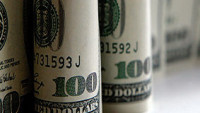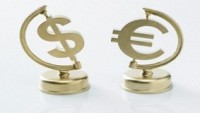 Here are the latest developments in global markets:
Here are the latest developments in global markets:
FOREX: The dollar index is higher on Tuesday, albeit by less than 0.10%, looking to extend the marginal gains it posted in the previous session. Meanwhile, the euro spiked higher after ECB chief Mario Draghi struck a more upbeat tone with regards to the bloc’s economic outlook. The pound also bounced as the UK’s Brexit Secretary Raab downplayed some fears. All these came largely at the expense of the yen, which was the main underperformer on Monday, and continues to trade on a soft note today.
STOCKS: It was a rocky session in Wall Street on Monday, with the Dow Jones (-0.68%) and the S&P 500 (-0.35%) closing lower as trade fears kicked in again, following China’s rejection to hold talks with the US. That said, the Nasdaq Composite managed to gain slightly (+0.08%), amid a rotation back into tech stocks. Meanwhile in Asia on Tuesday, Japan’s Nikkei 225 (+0.29%) and Topix (+1.02%) climbed on their first day back after a holiday, boosted by weakness in the yen. Markets in Hong Kong and South Korea remained closed. In Europe, futures tracking all the major indices were flashing green, pointing to a higher open today amid rumors that Italy’s coalition government may compromise on a budget deficit of less than 2%, avoiding a clash with the EU over fiscal rules.
COMMODITIES: Oil soared on Monday and is higher on Tuesday as well, with WTI gaining 0.35% to trade at $72.31, and Brent crude gaining 0.48% today to touch $81.59, a new four-year high. The surge came as major OPEC and non-OPEC producers including Russia appeared reluctant to raise their production in a meaningful manner, to offset supply outages stemming from Iran and Venezuela, among others. In precious metals, gold is up by a marginal 0.11% on Tuesday, trading just one dollar below the round figure of $1,200 per ounce, and remaining confined inside the narrow range it established over the past month.
The highlight during Monday’s trading session were some rather optimistic remarks by ECB President Mario Draghi, which triggered a spike higher in the euro. Striking a more confident tone than usual, Draghi said the ECB sees “a relatively vigorous pick-up in underlying inflation”, adding that the continued progress in the labor market and recent signs of shortages are likely to continue pushing wages higher.
Euro/dollar immediately spiked higher to a three-month high of 1.1815 as markets brought forward the expected timing of the first ECB rate increase, though the pair later gave back nearly all its gains to end the session nearly flat, as the dollar recovered ground. The first 10bps ECB rate hike is now fully priced in for September 2019, with investors assigning another 79% probability for another one by December 2019, according to market-implied pricing derived from EONIA swaps and Euribor futures.
Strangely enough, sterling outperformed even in the absence of any fresh Brexit news, recovering some of the sizeable losses it recorded last week. The rebound came after the UK Brexit Secretary Raab downplayed fears of a no-deal scenario, maintaining an optimistic tone overall but delivering little of real substance. Overall, most pundits still appear to view the prospect of a deal as being much more probable than a no-deal, which helps explain much of the recovery in sterling lately. That said, there’s still no realistic proposal on the table for the Irish border, and with the UK now “digging its heels” and waiting for the EU to make concessions, it may well be a case of markets overestimating the likelihood of a near-term breakthrough in the talks.

Tuesday calendar is near empty, with the US Conference Board’s consumer confidence index and some data on US house prices being on the agenda. Meanwhile, any updates on global trade, Brexit, or eurozone politics will be eyed.
On the data front, the CaseShiller indices gauging house prices in the US during July are due at 1300 GMT. Elsewhere, September’s consumer confidence index will be made public at 1400 GMT. US consumer sentiment – upbeat views on the labor market – pushed the index to a near 18-year high in August. The gauge is projected to ease a bit in September, though still remain at elevated levels.
On trade, investor angst over Sino-US relations remains in the background. On Canada-US trade negotiations, reports suggest that informal talks may take place during the UN meeting in New York. Japanese PM Shinzo Abe will also be meeting US President Donald Trump in New York to discuss trade, with a summit being on the agenda tomorrow.
In eurozone politics, Italy’s Five Star Movement and League ruling parties are pushing for a budget that will allow them to follow through with their campaign promises. This, though, may lead to a clash with the European Commission (as expressed above, there are rumors for a budget compromise). In Germany, it’s unclear whether nerves have calmed after disagreements between the governing coalition parties that pointed to a fragile Merkel leadership.
Sterling is yet again expected to be sensitive to any Brexit news.
In terms of policymakers’ appearances, ECB chief economist Peter Praet will be making public remarks at 0810 GMT, 1045 GMT, and 1330 GMT. Of note, the second of the three appearances will pertain to a discussion titled “Where next for the euro”. Other policymakers on the agenda are Bank of England MPC member Gertjan Vlieghe (0840 GMT) and ECB board member Benoit Coeure (1200 GMT).
In energy markets, weekly API data on US crude stocks are due at 2030 GMT.

AUDUSD has lost ground after reaching a four-week high of 0.7303 on September 21. Earlier on Tuesday, it touched a six-day low of 0.7235. The RSI has been declining overall in recent days and after entering overbought levels, pointing to negative short-term momentum. However, the indicator is attempting a move higher at the moment; this may be an early indication of changing momentum. Also, the stochastics are giving a bullish signal in the very short-term, as the %K line has moved above the slow %D one.
Intensifying Sino-US trade tensions are likely to weigh on the export- and China-dependent aussie, pushing AUDUSD lower. Given a move below the lower Bollinger band at 0.7239 – the zone around this captures the current level of the 50-period moving average line at 0.7228 and the earlier hit low of 0.7235 – support may come around the 100-period MA at 0.7194, including the 0.72 handle. A previous low at 0.7150 would come into view in case of steeper losses, before September 11’s two-and-a-half year low of 0.7084 is eyed next.
On the upside and in case of easing tensions, resistance may come around the middle Bollinger line – a 20-period MA line – at 0.7271. Not far above lies the four-week high of 0.7303 from September 21; the upper Bollinger band coincides with this peak, with the 0.73 round figure also being part of the area around this point. Further above, the region around the one-and-a-half-month high of 0.7381 from late August would come into focus.
Origin: XM













